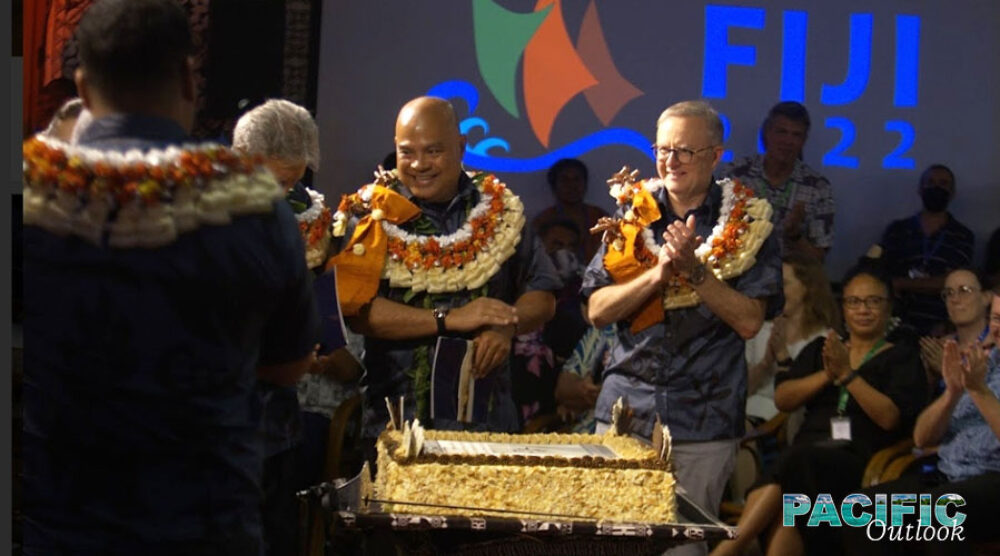AUDREY AUMUA AND SOLI MIDDLEBY |
Considering recent commentary on the Pacific Islands Forum (PIF) and Pacific regionalism, you could be forgiven for missing the significance of what occurred last month. It is not every day that diverse nations come together to define a new continent and assert a geopolitical vision and strategy for it.
Perhaps an appreciation of the 2050 Strategy approved at this year’s PIF is only possible in its historical context. For outsiders, this history is one of the geostrategic competitions over small, fragile nations needing development and protection. For insiders, it is one of deeply interconnected identity that respects diversity and sovereignty, and of many achievements, from the world’s first farmers and oceanic navigators to the Law of the Sea and the Treaty of Rarotonga.
Over the last decade, the insider view has grown louder. Sir Mekere Morauta’s review of regionalism in 2013 catalysed significant reforms that enabled both greater inclusivity of the Pacific people and stronger political debate. Alongside an assertive ‘new Pacific diplomacy’ on climate change and the arrival of the Pacific-only Pacific Islands Development Forum, the region has increasingly positioned itself as a geo-strategically important site of sovereignty and power.
This culminated in 2017 when leaders endorsed a Blue Pacific identity as the driver of Pacific regionalism and recognised the need to act as one Blue Continent, creating a clear geopolitical vision for the region. Now, in 2022, a comprehensive strategy has been agreed to guide the Blue Continent’s ambitions over the next three decades.
So why is the 2050 Strategy so different?
For starters, unlike its predecessor, the Pacific Plan, the 2050 Strategy’s development has been Pacific-led and determined. The agenda for 2050 was set by Pacific leaders, the process of negotiation and consultation was carried out over two years by the Pacific people and the final consensus was agreed upon by the apex of Pacific political leadership, the PIF.
Second, it has an extremely high level of commitment and ownership from the region. The Forum Chair, Fiji and the Forum Secretariat ran a highly inclusive process, primarily led at the national level that then worked collectively to determine regional priorities. The ownership of Forum membership and the commitment from regional stakeholders to the 2050 Strategy was clearly demonstrated in the PIF dialogues and communique.
Finally, it is actually a strategy. It provides a long-term vision for the Blue Continent and outlines steps to achieve this vision. It provides clear priorities for collective action, both building on and replacing the inclusive priority setting process articulated by the Framework for Pacific Regionalism, and the opportunity to develop long-term approaches to critical uncertainties and challenges.
While the 2050 Strategy should be celebrated for these reasons, no one is under the illusion that it will be easy to translate Pacific ambitions into action.
Delivery of the 2050 Strategy will need a fit-for-purpose regional architecture with the ‘requisite governance and resourcing arrangements that promote, govern, and deepen collective responsibility and accountability’ of the strategy. This architecture is complex, inclusive of over a hundred agencies with different mandates, memberships, governance structures, and financing.
While PIF Leaders have requested a member-led comprehensive review of the regional architecture to be delivered at the next PIF Leaders’ meeting this task will be no mean feat. Further, neither the appetite nor the incentives to reform the governance and financing of regionalism have been strong in the past. For example, will development partners really get behind a Pacific-led strategy or continue to broadly align while actually determining their own strategic priorities for their funds?
A second challenge will be to keep the politics in Pacific regionalism and not return to a situation in which bureaucrats turn the political agenda of regionalism into a technocratic one. While the 51st Leaders Retreat was not the display of robust political dialogue on issues such as climate change and West Papua, this was a strategic political decision to focus on re-establishing regional momentum lost throughout the pandemic and the significant concerns of PIF’s Micronesian members.
Perhaps the biggest risk to the strategy is the nature of the debate itself and the level of cynicism towards regionalism. Significant initiatives discussed at PIF such as Niue’s new Sustainable Financing Mechanism – Ocean Conservation Credits, Tuvalu’s Future Now project or the historic signing of a maritime boundary between Solomon Islands and Fiji warranted little attention from the 160 media present in Suva, overshadowed by geopolitical issues and analysis of the larger countries.
Debate on the Strategy and regionalism more broadly would be richer if more attention was paid to the role all nations play and if there was more preference given to Pacific voices. Failure to acknowledge the successes of Pacific regionalism as well as provide well-informed critiques only serves to perpetuate the outside framing that the Blue Pacific is seeking to dismantle.
The 2050 Strategy is not a magic bullet, its approval didn’t stop the election violence in Papua New Guinea, nor the storm swells that lashed Cook Islands, French Polynesia and American Samoa. However, if some of these things can shift, it has a real chance of delivering transformations to the lives and wellbeing of Pacific people.
Dr Audrey Aumua is the Chief Executive of Fred Hollows Foundation NZ and the former Deputy Director General of the Pacific Community (SPC) and Country Director of the World Health Organisation, Solomon Islands.
Soli Middleby is a PhD candidate in the Department of Politics and International Relations at the University of Adelaide and a former Australian diplomat to the Pacific and CEO of the Australian Pacific Training Coalition.








